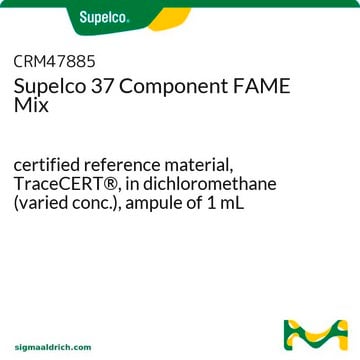Kluczowe dokumenty
52619
Hexamethyldisilazane
for GC derivatization, LiChropur™, ≥99.0% (GC)
Synonim(y):
HMDS
Wybierz wielkość
402,00 zł
Wybierz wielkość
About This Item
402,00 zł
Polecane produkty
klasa czystości
derivatization grade ((GC derivatization))
for GC derivatization
Poziom jakości
Próba
≥99.0% (GC)
Formularz
liquid
jakość
LiChropur™
przydatność reakcji
reagent type: derivatization reagent
reaction type: Silylations
metody
gas chromatography (GC): suitable
współczynnik refrakcji
n20/D 1.407 (lit.)
n20/D 1.408
bp
125 °C (lit.)
ciąg SMILES
C[Si](C)(C)N[Si](C)(C)C
InChI
1S/C6H19NSi2/c1-8(2,3)7-9(4,5)6/h7H,1-6H3
Klucz InChI
FFUAGWLWBBFQJT-UHFFFAOYSA-N
Szukasz podobnych produktów? Odwiedź Przewodnik dotyczący porównywania produktów
Powiązane kategorie
Opis ogólny
Zastosowanie
It may be used as a derivatizing reagent for the analysis of bioamines and their acidic metabolites,[3] phenol, hydroquinone and catechol[4] in urine samples, mixtures of free fatty acids and metal soaps in paint samples[5] using gas chromatography/mass spectrometry (GC/MS).
Cechy i korzyści
- HMDS is inexpensive and has a relatively low boiling point (124-127 °C).
- It can be used without solvent but its silylating power can be increased by various (mostly acidic) catalysts.
- The only reaction byproduct, ammonia, can leave the reaction mixture as the reaction goes to completion.
Inne uwagi
Informacje prawne
Hasło ostrzegawcze
Danger
Zwroty wskazujące rodzaj zagrożenia
Zwroty wskazujące środki ostrożności
Klasyfikacja zagrożeń
Acute Tox. 3 Dermal - Acute Tox. 4 Inhalation - Acute Tox. 4 Oral - Aquatic Chronic 3 - Flam. Liq. 2
Kod klasy składowania
3 - Flammable liquids
Klasa zagrożenia wodnego (WGK)
WGK 2
Temperatura zapłonu (°F)
52.5 °F - closed cup
Temperatura zapłonu (°C)
11.4 °C - closed cup
Środki ochrony indywidualnej
Faceshields, Gloves, Goggles, type ABEK (EN14387) respirator filter
Wybierz jedną z najnowszych wersji:
Masz już ten produkt?
Dokumenty związane z niedawno zakupionymi produktami zostały zamieszczone w Bibliotece dokumentów.
Produkty
Results of a study involving the ability few Fluka silylating reagents to form GC-MS-compatible trimethylsilylmethyl derivatives of NSAIDs
Active Filters
Nasz zespół naukowców ma doświadczenie we wszystkich obszarach badań, w tym w naukach przyrodniczych, materiałoznawstwie, syntezie chemicznej, chromatografii, analityce i wielu innych dziedzinach.
Skontaktuj się z zespołem ds. pomocy technicznej






